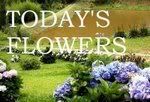In the early beginnings of spring the queen starts laying eggs to reproduce her colony. The worker bees (all female) start foraging for food (nectar and pollen) to feed the new baby bees, which we call c-cells. C-cells- because when you look inside of the cell after about a week from being laid the egg looks like a very tiny c, a bee larvae.
The foragers bring the nectar(which they make into honey) and pollen back to the hive and place it around and in the four corners of the comb around the larvae. They use this to feed the growing babies.
When they start "feeling" cramped for space they start pulling down a queen cell...actually several queen cells. This is a time for the beekeeper to "bee" on time and check each frame carefully. Honeybees can hatch a queen and swarm before you realize it. The days go by so fast! lol
A lot of people have been asking me certain questions about our bees. Here are some pictures that I've taken over the time we've had them.
Capped honey, Once spring has sprung and before the nectar flow we put what is called a super onto the top of the hive. It has smaller frames, the bees will pull these frames out into cells and store honey in them. After it is capped this can be taken and harvested. Provided the beekeeper hasn't used any medication during the flow. We are all natural with our bees. No medication at all, I feel it brings them down worse than letting nature take care of things. If you keep your hives as strong and healthy as you can, they'll pull through a lot better and stronger without medications.

Un-capped honey, can you see the taste tester? LOL

Honey starting to be capped.

C-cells, can you see them? On the ninth day the worker and queen larvae is capped. You can see the capping in the lower part of this picture. The mixture and texture of the capping is different from the capping of honey which is pure bees wax. The capping of brood (baby bees) has a papery texture very easy for them to chew through.

Here you can see the papery capping's of brood. The honey is above and on the sides and corners of the brood frame.

Here is the begging of a queen cell. She has to have a much larger cell.....after all she's going to Bee a Queen!

Another picture of capped brood, c-cells and uncapped honey and the queen. Can you pick her out?

The swarm of bees ball up around the queen to protect her. This swarm was from a wild hive. It was on land where beekeepers don't have hives for many, many, many miles. They more than likely came from a hollow tree deep in the woods. During this time of year "controlled" burning takes place and that's probably what spurred the swarm into action. I'm so glad we were called.

Lucky for us this swarm was at a good height and I was able to put the truck underneath the ball of bees. I also brought the six foot ladder and my husband climbed up to cut the branch. The trouble is he only has two arms! LOL

As you can see he needed them both to cut the limb, so I climbed up to hold the branch. No one is around willing to take pictures of this feat. I might add that I was not suited up at all for this swarm rescue either! Boy, I'm getting braver the younger I get! LOL Braver???? More like nuttier!! But here again, no stings! They can sense fear and my goal as a beekeeper is to be able to go into our hives gloveless. I was around the bees yesterday with them flying all around me and I even caught the queen with a queen catcher. How cool is that!

This is before we found the queen, when my husband tried to shake them into the nuc box the queen flew off onto the back of the truck. Right there around the back light next to the box. After I caught her I put her into the box and a while later we were on our way home.

All tucked away safely in their new home.
 So, spring is swarm season....I do hope that more and more people will come to realize that we need our pollinators. They are NOT out to do us harm...please let them live and in turn they will provide us with a bounty of food and enjoyment beyond measure! Parents please teach your children...young and old! You'll "bee" glad you did!
So, spring is swarm season....I do hope that more and more people will come to realize that we need our pollinators. They are NOT out to do us harm...please let them live and in turn they will provide us with a bounty of food and enjoyment beyond measure! Parents please teach your children...young and old! You'll "bee" glad you did!
BEE SWEET!
Julie





















AWSOME PHOTOS.
ReplyDelete